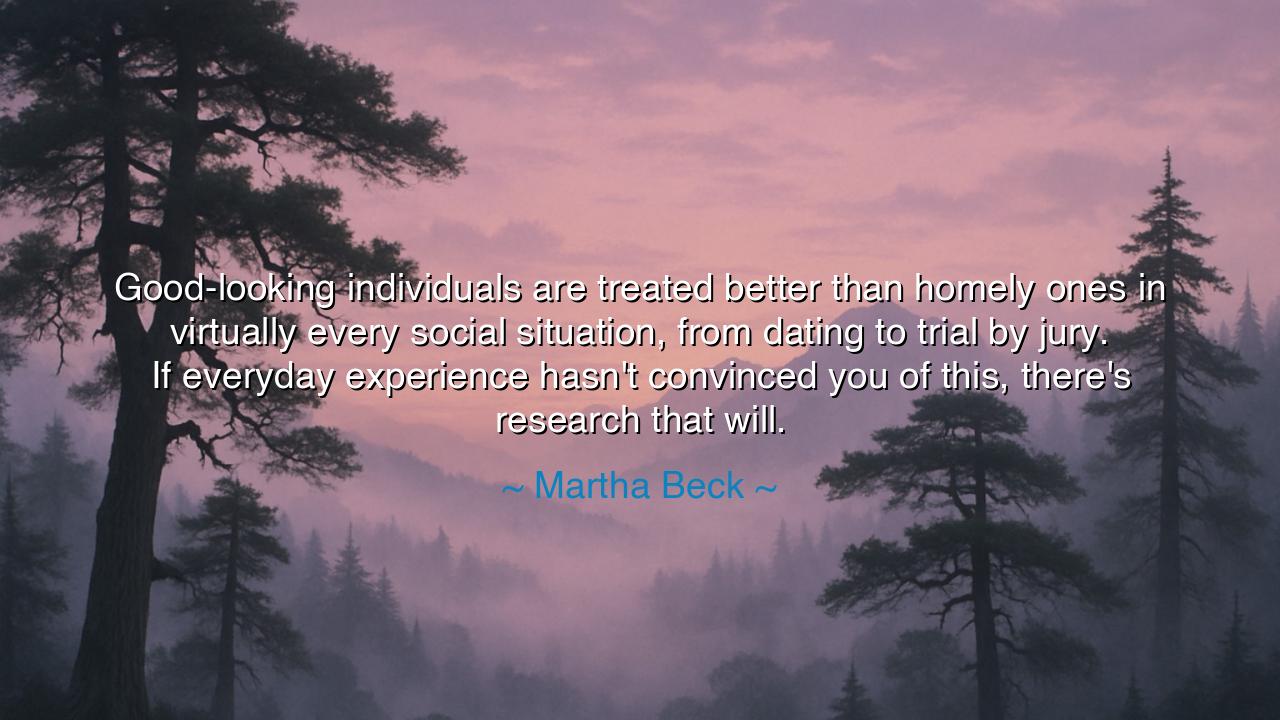
Good-looking individuals are treated better than homely ones in
Good-looking individuals are treated better than homely ones in virtually every social situation, from dating to trial by jury. If everyday experience hasn't convinced you of this, there's research that will.






In the marketplace of mortal judgment, a hard saying rings out like a bronze bell: “**Good-looking** individuals are treated better than homely ones in virtually every social situation, from dating to trial by jury… and if experience fails to persuade, there is research that will.”** Beneath the plainness of this saying lies an old and bracing wisdom: the eye is a swift tyrant, crowning some and overlooking others before the heart has time to inquire. The face becomes a banner; the world salutes or passes by. Thus the ancients taught us to distrust first glances and to school the gaze, lest we bow to idols made of symmetry and light.
This bias has a venerable name among the scholars: the halo effect—that glittering fog wherein one pleasing trait spreads unearned glory over the rest. We see a straight nose and imagine a straight character; we mistake clear skin for a clear conscience. In tavern and temple, office and senate, the good-looking are waved through inner gates while the homely wait at the outer wall. The saying does not praise this order; it merely unmasks it. And it warns us that the flattering lie we tell ourselves—“I judge only by merit”—can be broken by both memory and measurement.
Consider the tale of Phryne of ancient Greece, a courtesan tried before the Areopagus for impiety. Her advocate, Hypereides, in a legend oft retold, bared her to the jurors, and the sight of her beauty—like Aphrodite risen from the foam—swayed their verdict to mercy. Whether every detail be myth or memory, the moral is iron: in a trial by jury, the eye may storm the ramparts of reason. The court, built for logos, bowed to the pathos of a face. So too do we, in gentler courts each day—hiring, grading, befriending—acquit or condemn by the brief sun of appearance.
Our own age adds instruments to intuition. The scrolls of research—experiments, replications, meta-analyses—speak with cold harmony: the good-looking are rated more competent, more trustworthy, more worthy of love; they are offered higher wages and gentler sentences; they win more second dates and, at times, more sympathetic juries. The numbers are not destiny, but they are drumbeats in the dark. If everyday experience has not taught us this, the laboratories have lifted the lamp to show our steps.
Yet wisdom does not end in lament. It commands a counter-ritual: to build ways of seeing that interrupt the tyranny of the glance. The musicians of great orchestras learned this and drew a veil—blind auditions—so that sound, not face, would be judged; and the gates opened to players once overlooked. So too can our councils and companies veil what seduces the eye: structured interviews, anonymized résumés, rubrics that hold us steady when the smile tilts the scales. In friendship and dating, we can slow the choosing and ask, “What does this soul keep when the mirror is gone?”
Let there be, also, a gentleness toward ourselves and others. The homely are not cursed; the good-looking are not guilty. But all are tempted—to scorn or to coast—by the gifts and lacks of visage. The charge, then, is to hunger for realism in judgment: to weigh habit over cheekbone, patience over jawline, courage over color of eye. Praise those who train their attention upon the quiet virtues; become one who wears such virtues like armor.
Rites for the road: (1) When you must judge, write your criteria before you look; hold to them after you look. (2) In your circle, esteem acts—kept promises, tended wounds—above surfaces; make this esteem audible. (3) In your own heart, cultivate a practice of “second sight”: after the first impression, take one full breath and name three non-visual reasons to honor or withhold honor. (4) Where you hold power—classroom, courtroom, boardroom—cover the face when you can and uncover the evidence always. Do these things and you will make of your eyes not a throne but a window, and of your judgments not a reflex but a covenant. Then the bell of the saying will no longer toll as doom, but as a summons to justice answered.






AAdministratorAdministrator
Welcome, honored guests. Please leave a comment, we will respond soon